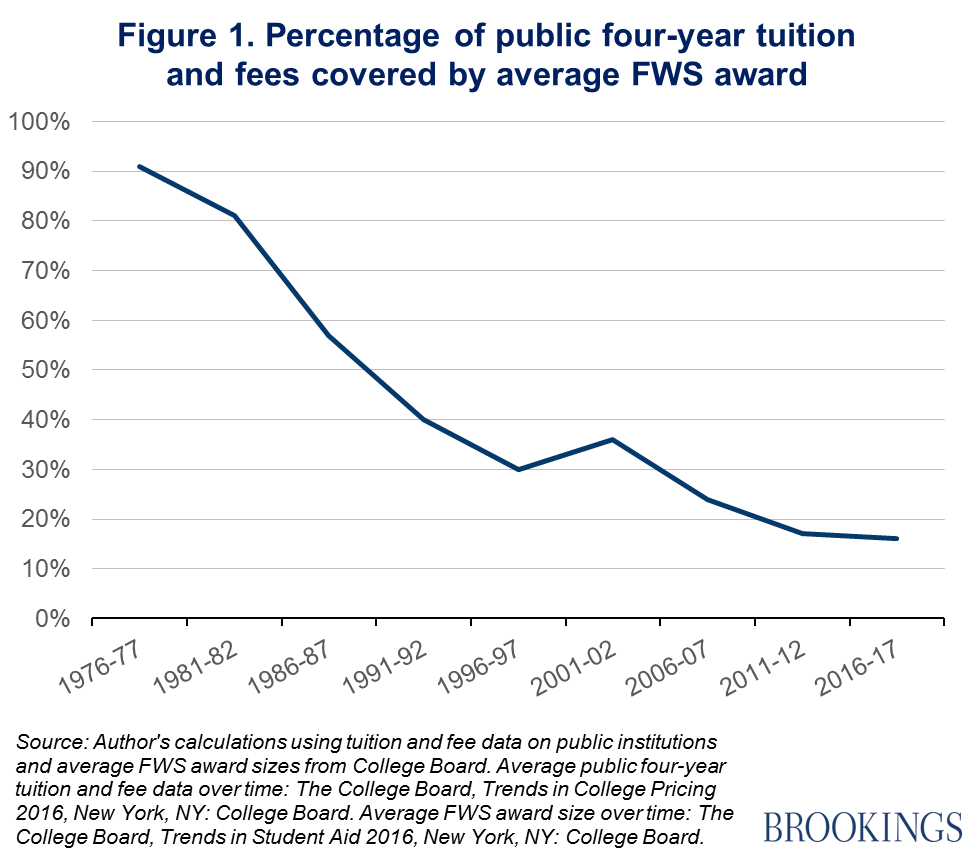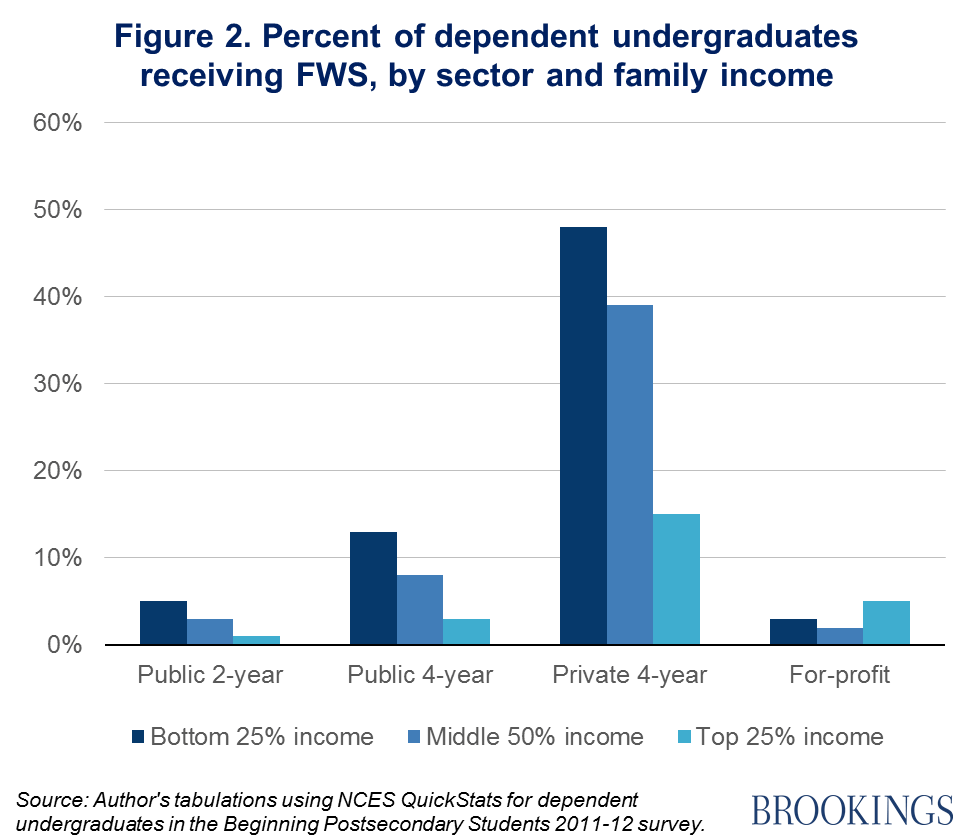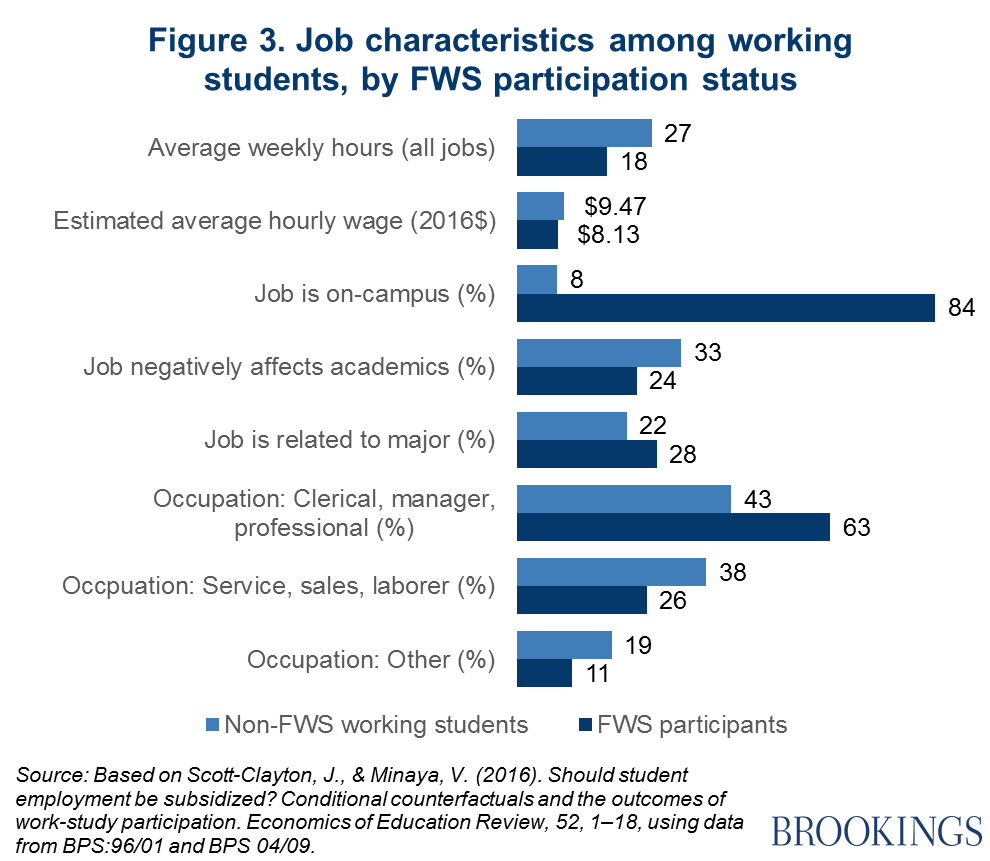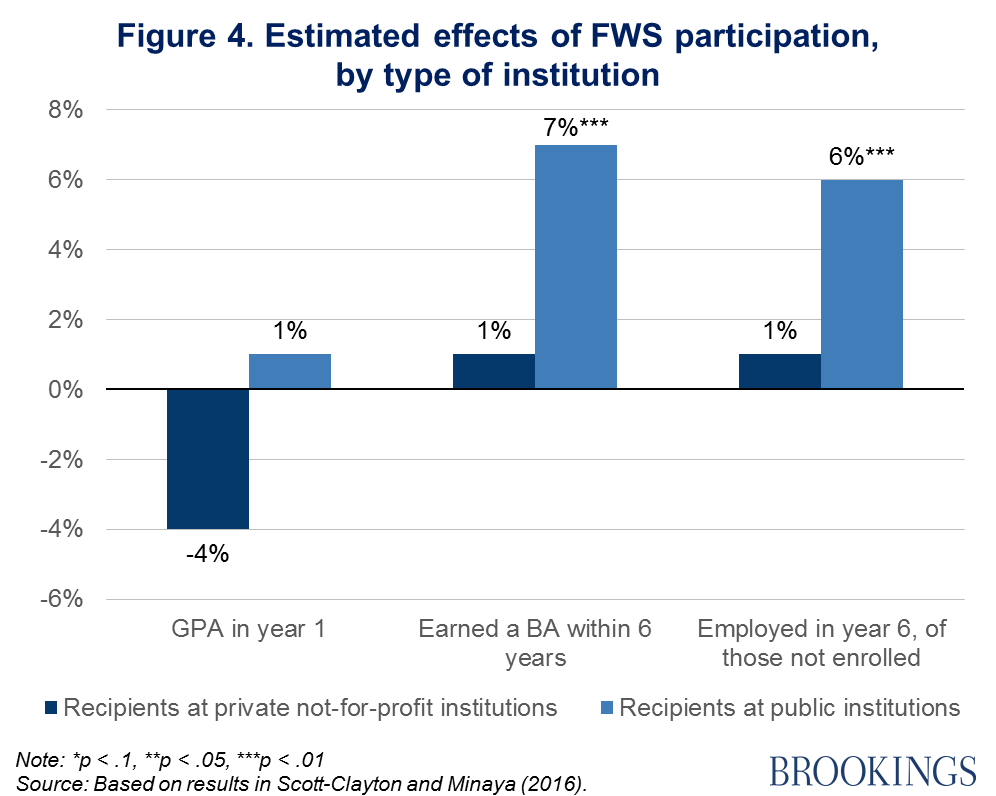
Executive Summary
Federal Work-Study (FWS) is on the chopping block: the Trump administration’s recently-released budget summary seeks to cut program funding by nearly 50 percent, from $990 million to $500 million, and to “reform the program to ensure funds go to undergraduate students who would benefit most.” [1] Many observers have expressed surprise that the administration would take aim at the program—which seems well-aligned with conservative ideals around personal responsibility and work-based learning—even as President Trump takes executive action to support and expand apprenticeships. [2]
Perhaps we shouldn’t be so surprised, though. Beloved as the program may be across the political spectrum, hard evidence regarding its effectiveness is sparse. And frustrations have long simmered over the way FWS funds are unequally distributed across colleges. Finally, in important ways, the program’s original justification—to encourage students to work while enrolled in order to pay their way through college—is profoundly outdated.
In this research note, I discuss the theory and evidence relating to work-study to answer the question: is the idea of work-study past its prime? Or might the program have a unique and valuable role to play in a modern “college completion and career readiness” agenda?
I argue that two recent trends in higher education provide the program with newfound relevance: first, an increasing recognition of behavioral and structural barriers to college persistence and completion (not just financial ones), which on-campus employment might help address; and second, the increasing importance of internships in the post-college job market, in combination with the fact that access to such internships is often unequal by family income. Indeed, the available research on FWS, while not definitive, suggests that it improves both degree completion and the likelihood of employment after college, in part by replacing off-campus jobs with more academically-compatible on-campus ones.
Policymakers on both sides of the aisle in Congress may support the administration’s goal of improving how FWS funds are targeted. But ultimately it’s not possible to cut the program in half without sharply reducing access for those students that appear to benefit most: low-income students at public institutions. Rather than sending stakeholders scrambling for ways to minimize damage from such drastic cuts, energy would be better spent innovating, experimenting, and rigorously evaluating this half-century old program that still appears to have a valuable place in a modern college completion and career readiness agenda.
The origins of Federal Work-Study
The Federal Work-Study program was introduced as part of the Economic Opportunity Act of 1964, with the goal of enabling low-income students to “work their way through college.” It is thus one of the earliest forms of federal financial aid for college, pre-dating both Pell Grants and Stafford Loans. Since its inception, FWS has provided institutions with funds to subsidize up to 75 percent of eligible students’ wages (with institutions funding the remainder), encouraging them to employ students in part-time, educationally-relevant jobs. The FWS program has an extensive reach, serving over half a million students each year, including one out of every 10 full-time undergraduates.
Despite its broad reach, FWS today is no longer of great significance in terms of helping students finance the cost of college. The $1 billion dollar program is dwarfed in size by Pell Grants ($28 billion annually) and federal student loans ($100 billion for undergraduates annually). [3] In the mid-1970s, the average FWS award would cover over 90 percent of tuition and fees at a typical four-year public institution (see Figure 1). But as award amounts have atrophied and tuition and fees have skyrocketed, today’s typical FWS award (about $1,550 per year) now covers only 16 percent of today’s average public tuition and fees.

Further diluting its original justification, the program is no longer specifically targeted to low-income students. The original 1964 legislation required that recipients be low-income; later, this was amended to specify that such students be given first priority. Today, as long as students submit a Free Application for Federal Student Aid (FAFSA) and have some financial need, institutions have great discretion in determining how to prioritize among many eligible applicants.
Moreover, the type of institution attended, rather than family income, is often the biggest determinant of access to the program. The antiquated formula that allocates FWS funds to institutions gives priority to selective private institutions (which had savvy grant-proposal writers in the 1960s when allocations were first determined). [4] For example, New York University receives more FWS funds annually than all of the City University of New York’s 24 institutions combined. [5] As a result, a high-income student at a private four-year college is more likely to receive FWS than a low-income student at a public four-year college (see Figure 2). [6]

Finally, in contrast to the 1960s and 1970s, the vast majority of today’s college students (66 percent) already work at least part-time, even if they don’t receive FWS. [7] And while the program originally required FWS jobs to be educationally-relevant, today institutions are only required to provide educationally-relevant opportunities “to the maximum extent possible.”
Federal Work-Study’s role in the modern higher education landscape
It is thus fair to ask: what precisely is the added value of FWS, when other federal programs provide more substantial and better-targeted forms of financial aid, and when the private sector already provides ample opportunities for students to work? One answer is that the vast majority of non-FWS student employment is off-campus, typically in low-skill jobs with no connection to students’ majors, and often with little consideration for students’ academic schedule and goals. For many participants, FWS means access to a better-quality, more academically compatible job.
For example, as shown in Figure 3, the typical student in a non-FWS job reports working an average of 27 hours per week, with fewer than one in 10 working on campus. These jobs may impede rather than promote academic success. Indeed, the increasingly prevalent challenge of juggling school and work may be a key factor behind lagging degree completion rates and lengthening time-to-degree. [8] By enabling students to switch from off-campus to on-campus jobs, FWS can actually reduce weekly hours of work, free up time spent in transit, and enable students to more fully integrate into their campus community, all of which could positively influence persistence and completion. [9]

FWS jobs may also provide more career-relevant work experiences. Figure 3 shows that FWS jobs are substantially more likely to be in clerical, managerial, or professional occupations, while non-FWS jobs are more likely to be in sales, service, or laborer occupations. FWS jobs are also more likely to be directly related to students’ majors. As the post-college labor market has become more competitive over time, recent surveys suggest that employers increasingly prioritize graduates with relevant work experience when making hiring decisions. [10] Yet not all students can afford to take high-quality unpaid internships just for the experience. FWS may help level the playing field of access to “good” undergraduate work experiences regardless of family income or networks.
What do we know about the effects of FWS?
FWS has never been evaluated via a randomized-control trial (RCT). This makes it difficult to confidently assess the causal effects of the program, separate from pre-existing characteristics which may simultaneously affect both who participates in FWS as well as subsequent academic and labor market outcomes (factors such as student’s academic ability, organization, or motivation). But three recent studies have used quasi-experimental methods, and a fourth study carefully matched participants with observably similar non-participants to provide suggestive evidence on the program’s consequences. [11]
These studies consistently suggest that compared to not participating in FWS, FWS employment may reduce first year grade point averages (GPAs), though the effect was small in three of the four studies and statistically insignificant in two of the four. [12] Modest negative effects in the short term, however, may be outweighed by positive effects on persistence and graduation over the longer term. Most notably, matching-based estimates from Scott-Clayton and Minaya (2016) suggest that FWS participation is associated with a 3 percentage-point increase in the likelihood of completing a bachelor’s degree within six years (p < .05).[13] Consistent with the potential mechanisms outlined above, Scott-Clayton and Minaya (2016) find that the positive effects of the program are concentrated among those students who likely would have worked in a different job had they not had access to FWS.
Scott-Clayton and Minaya’s (2016) study is the only one to examine the relationship of FWS participation to students’ labor market outcomes after graduation. The authors find that FWS participation is associated with an increased likelihood of being employed six years after initial enrollment (a modest, but statistically significant 2 percentage point increase; p < .05). The same study also finds striking patterns of heterogeneity. As shown in Figure 4, recipients at public institutions appear to derive substantially greater benefits from the program.

The authors similarly find that low income recipients appear to benefit more from participation than high income recipients (though the pattern is somewhat muted, compared to the pattern by institution type). This pattern of findings is consistent with a story in which increased on-campus integration and improvements in job characteristics are important drivers of program effects. Higher-income students at selective private institutions may derive less benefit because they may already spend most of their time on campus and have access to high-quality work experiences, if they want them, even in the absence of an FWS job.
Implications for policy
The Trump administration has not yet specified how their proposed 50 percent reduction would be distributed, other than to state that funds would be “better targeted.” In theory, better targeting of existing funds is an idea that could unite policymakers from across the aisle. [14] For example, an institution’s FWS allocation could be based upon its enrollment of Pell-eligible students, rather than upon historical arrangements. Or, student eligibility could be limited to those below a given income (or below a given EFC, the summary measure of need for federal student aid applicants).
Institutions may also be able to adjust their targeting strategies to minimize negative consequences and maximize the potential benefits of FWS participation. Based on the available research evidence, institutions that are not already prioritizing low-income students in their FWS awarding strategy might consider doing so. They might also consider giving priority to students who indicate a likelihood of off-campus employment in the absence of FWS.
Ultimately, however, it’s simply not possible to cut the program in half without sharply reducing access for those students that appear to benefit most: low-income students at public institutions. And if the average 3-percentage-point BA completion effect is taken at face value, cutting the number of participants in half would lead to nearly 10,000 fewer BA graduates six years from now, representing perhaps $2.5 billion in net-present-value losses from reduced lifetime wages for a savings of just $500 million today. [15]
Rather than scrambling for ways to minimize damage from such sudden and drastic funding cuts, energy would be better spent innovating, experimenting, and rigorously evaluating this half-century old program that still appears to have a valuable place in a modern college completion and career readiness agenda.
— Judith Scott Clayton

Judith Scott-Clayton is Associate Professor of Economics and Education at Teachers College, Columbia University.
This post originally appeared as part of Evidence Speaks, a weekly series of reports and notes by a standing panel of researchers under the editorship of Russ Whitehurst.
The author(s) were not paid by any entity outside of Brookings to write this particular article and did not receive financial support from or serve in a leadership position with any entity whose political or financial interests could be affected by this article.
Notes:
1. Fiscal Year 2018 Budget Summary and Background Information, U.S. Department of Education, p. 29. URL: https://www2.ed.gov/about/overview/budget/budget18/summary/18summary.pdf
2. https://www.washingtonpost.com/news/post-politics/wp/2017/06/15/trump-to-tout-apprenticeships-turning-to-an-issue-with-bipartisan-support/?utm_term=.81f3f242c075
3. Pell Grant undergraduate student loan totals are from: The College Board, Trends in Student Aid 2016, New York, NY: College Board.
4. See Smole, D.P. (2005). The campus based financial aid programs: A review and analysis of the allocation of funds to institutions and the distribution of aid to students. Washington, DC: Congressional Research Service.
5. Author’s calculations using U.S. Department of Education FWS Allocation data by institution for 2009-10 (obtained via direct request).
6. See Scott-Clayton, J. and Zhou, R.Y. (2017). Does the Federal Work-Study Program Really Work—and for Whom? A CAPSEE Research Brief (March 2017). New York, NY: Center for the Analysis of Postsecondary Education and Employment.
7. Author’s tabulations using NCES Quick Stats, National Postsecondary Student Aid Survey, 2011-12, limited to undergraduates, weekly hours of work greater than zero. See Scott-Clayton (2012) for additional information on long-term trends in college student employment.
8. Turner, S. (2004). Going to college and finishing college: Explaining different educational outcomes. In Hoxby, C. (ed.) College choices: The economics of where to go, when to go, and how to pay for it (pp. 13-62). Chicago: University of Chicago Press. For further discussion of trends in undergraduate employment, see Scott-Clayton, J. (2012). What explains trends in labor supply among US undergraduates? National Tax Journal 65 (1): 181-210.
9. Tinto, V. (1975). Dropout from higher education: A theoretical synthesis of recent research. Review of Educational Research, 45, 89–125.
10. See Kathryn Anne Edwards and Alexander Hertel-Fernandez (2010), Paving the Way through Paid Internships: A Proposal to Expand Educational and Economic Opportunities for Low-Income College Students. Washington, DC: Demos. http://www.demos.org/sites/default/files/publications/PavingWay_PaidInternships_Demos.pdf.
11. Three studies use variation in FWS access due to arbitrary policy decisions in order to identify causal effects: Stinebrickner, T., & Stinebrickner, R. (2003). Working during school and academic performance. Journal of Labor Economics, 21(2), 473–491. Scott-Clayton, J. (2011). The causal effect of federal work-study participation: Quasi-experimental evidence from West Virginia. Educational Evaluation and Policy Analysis, 33(4), 506–527. Soliz, A., & Long, B. T. (2016). Does working help or hurt college students? The effects of federal work-study participation on student outcomes (CAPSEE Working Paper). New York, NY: Center for Analysis of Postsecondary Education and Employment. A fourth study uses propensity score matching, under the assumption that access to FWS varies idiosyncratically after controlling for a rich set of individual, family, and institutional characteristics: Scott-Clayton, J., & Minaya, V. (2016). Should student employment be subsidized? Conditional counterfactuals and the outcomes of work-study participation. Economics of Education Review, 52, 1–18.
12. In three of the four studies, the comparison is simply to “whatever students do otherwise if not assigned to FWS,” and thus FWS participation is compared to the average outcomes among non-participants, including those who end up working in other jobs and those that don’t work at all. FWS does not affect other grant aid received, but could affect borrowing decisions (Scott-Clayton and Minaya 2016 find that students who participate in FWS take out more student loans than non-participants). The comparison is somewhat different in the Stinebrickner & Stinebrickner (2003) study, because all students in their sample were assigned to work on campus (in fact, their study is not explicitly of FWS but rather of a mandatory on-campus work program that mimics FWS and is largely funded via FWS). Their study estimates the effect of getting assigned to a job where students work more versus fewer hours. This may explain why their effect estimates are substantially more negative than found in other contexts: they estimate the marginal effect of an additional hour of work in a context in which everyone is working at least 10 hours per week.
13. Stinebrickner & Stinebrickner (2003) do not examine outcomes beyond the first year. The quasi-experimental approach used by both Scott-Clayton (2011) and Soliz and Long (2016) leads to very imprecise and sometimes conflicting estimates of effects on persistence and graduation. Both of these studies find some evidence of positive effects for at least some outcomes and subgroups, but Scott-Clayton (2011) also finds some evidence of negative effects, especially for women. See Scott-Clayton and Zhou (2017) for additional details and discussion of the heterogeneity in these findings within and across studies.
14. See Kelchen, R. (2017). Campus-based financial aid programs: Trends and alternative allocation strategies. Educational Policy, 31 (4): 448-480.
15. In 2015-16, 632,000 students participated in FWS (College Board, 2016). If the program were cut in half, half of this group is estimated to experience a 3 percentage point reduction in graduation rates, or 9,450 fewer graduates. Estimates of the net present value of a bachelor’s degree are discussed in Avery, C. and Turner, S. (2012), Student loans: do college students borrow too much – or not enough? Journal of Economic Perspectives, 26, 165–192. The authors note that low estimates are around $250,000 while median estimates are much higher, between $450,000-$600,000.


